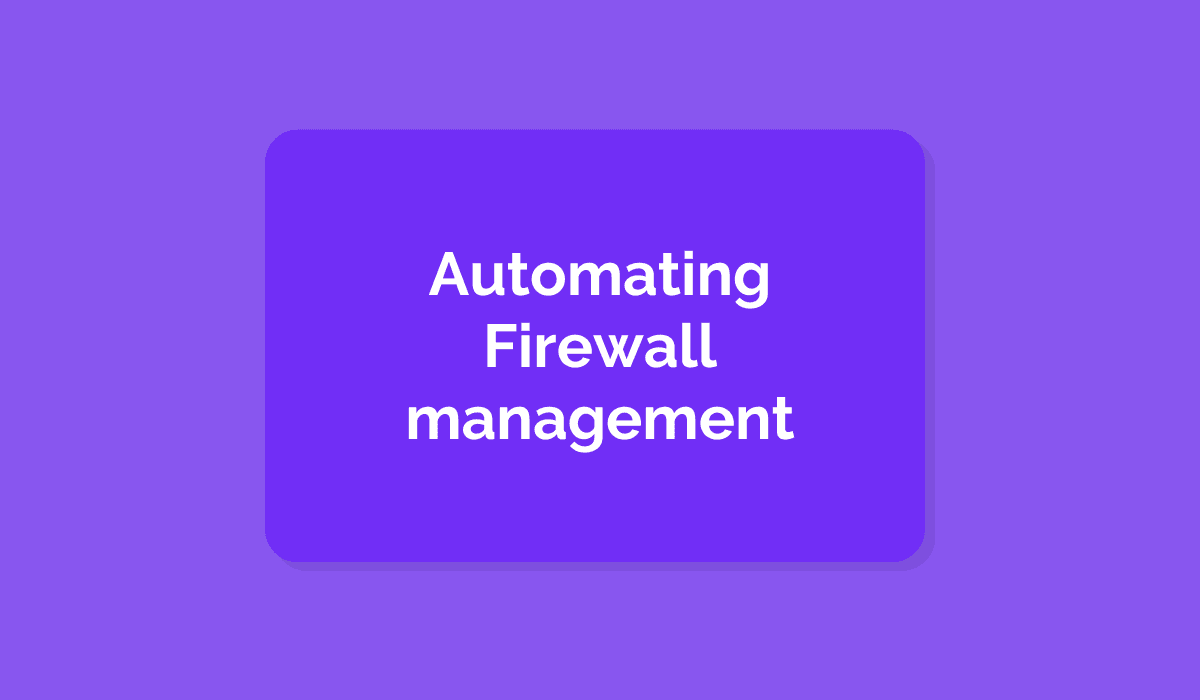Dec 14, 2022
Hugo
David
Why Firewall automation today? Firewalls (FW) are an essential part of any company's security. By controlling incoming and outgoing network traffic based on predetermined rules, they protect networks from unauthorized access and prevent malicious or unwanted traffic from entering or leaving networks.
The importance of firewalls can be seen in their variety and the number of companies providing them. Indeed, you have hardware and software-based FWs and massive players on the market. Cisco, Fortinet, Palo Alto, or Checkpoint are among the most widely used ones. They offer a range of FW products, including hardware-based (physical devices installed between your network and the Internet), software-based (installed on devices or servers), cloud-based (delivered as a service over the Internet and accessible through a web app), and network (controlling different segments of a more extensive network).
Today, as in many sectors, companies are looking to accelerate and, facing the growth of threats, are also looking to stay sharp when it comes to blocking unauthorized access. This is why more and more teams are looking for firewall automation. We're thus going to have a look at:
How FWs protect your company
The current challenges in deploying and maintaining firewalls
What firewall automation brings to the table; and,
a few concrete use cases as to why its essential today.
How do Firewalls work?
The firewall inspects the data transmitted between a computer or network and the Internet. When a packet of data arrives at the FW, it is compared against a set of rules that determine whether it should be allowed to pass through or be blocked. These rules can be based on various criteria predetermined, managed by the vendor, or custom-based, such as the source and destination of the data/traffic, the type of data/traffic (malicious, coming from unknown sources, or not authorized by the company's policies), the port number that the data/traffic is being sent to or received from, and the protocols being used to transmit this data/traffic.
As for the analyst, they typically use a firewall in several ways, like blocking incoming traffic from known malicious sources, such as specific IP addresses or websites. They can also use one to monitor outgoing traffic and block any data that does not comply with security policies. Additionally, an analyst can use an FW to create rules that allow only specific types of traffic to pass through it, such as web traffic or email traffic.
No wonder why firewalls are so widely adopted. They're an essential line of defense for your company by protecting networks from unauthorized access and malicious traffic. However, with the dramatic increase in traffic, the multiplication of sources and types of data, and the growth of threats, the proper maintenance of FWs are becoming increasingly time-devouring, if not difficult.
What are the current challenges when using them?
Although paramount for the company's security, firewalls present some issues that can refer to various problems that can arise when using one.
FWs aren't plug-and-play products. They have to be configured regarding the specifics of your network. It's even more critical since environments and applications are increasingly dynamic and complex. Keeping rules up to date is thus challenging and prone to misconfiguration. This issue happens ALOT. Considering different studies, a misconfiguration can be the source of unauthorized access in most cases. In 2016, Gartner estimated that misconfiguration causes 95% of all firewall breaches. Considering the growth of cloud computing and remote working altogether, making the networks more complex, this statistic is far from being reduced.
Because of this, your FW policies are often behind the current status of your applications and data. This means you are increasing risk in your network data center by manually managing rules. Firewall rules and policies can become outdated because of changes in your environment or may not be sufficient to protect against new threats that appear every day, requiring regular updates and maintenance.
Issues in misconfiguration can generate dangers such as: preventing users from accessing important resources or services, may allow unauthorized access to the network via inconsistent rules, misallocated ports, or the like, may block legitimate incoming traffic from assets on the cloud.
Turning to Firewall automation to reduce misconfiguration and stay up to date
Solving current challenges with Firewall automation
As we said above, the environment is becoming too complex to be handled manually. First, manually managing a FW necessitates experts. Second, it cost time and money. Third, changes depend on different teams, business processes, and tools. Relying on different teams or the like adds friction to managing already complex tasks. Forth, as implied by all the preceding factors, manually managing one is prone to errors that can cost a lot. And boom, here we go back to the study we talked about above.
Now that the circle is complete, how can we manage more efficiently and consistently? Of course, automation is often brought as a solution to these issues. Rightly so. By breaking silos between teams and pulling and pushing the right data to the right place, automation brings efficiency and consistency to FWs management.
This is why Automation platforms and FW technologies can and should work together to, ultimately, provide a more comprehensive security posture to your company. Automation platforms can integrate with such products to provide different benefits.
First, a smoother interface. New automation platforms share a focus on user experience, making the process more intuitive. Integrating with the FW helps maintain the configuration up to date directly from the platform, which reduces the pain of glass.
Second, managing the maintenance of FWs through an automation platform provides a more exhaustive view of your security posture.
Finally, firewall automation helps streamline FW ops. New access granted, new environment deployed? The end-user can manage to update the FW rules to stick up to date automatically. All in all, firewall automation helps reduce the time and effort required to manage the FW system and ensure that it is always up-to-date and properly configured. Use cases are various, as we're going to see now.
Examples of Firewall automation use cases
Yes, there are many use cases for automating security operations with firewalls and an Automation platform. Here are a few examples:
Automated rule updates: As said above, firewalls aren't always up to date. Sometimes, it will let through a threat that could be watched by other sensors. Typically, the SIEM gathers alerts generated by other sensors on the network. The alert is pushed to the Automation platform that pushes the artifact to threat intelligence databases for enrichment. Shall this alert be deemed malicious, the remediation process can plan to push the IOC directly into the firewall's rules and thus propagate this new rule across the network and help ensure that the firewall is always up to date and properly configured to protect the network from the latest threats.
Automated rule enforcement: More broadly, an automation platform can be used as a place to centralize and manage the enforcement of rules for a software-based firewall and automate the process of deploying the rules across the firewall system. This can help ensure that the firewall is properly configured and that only authorized traffic is allowed to pass through.
Automated threat intelligence: More proactively, an automation platform can integrate with a firewall and a threat intelligence database to first gather new IOCs reported in the threat intelligence database and then automatically update the firewall's rules. This can help ensure that the firewall is always protected against the latest threats and vulnerabilities, and it can help organizations stay ahead of emerging threats.
Automated compliance and audit: Thinking about loose access configurations. An automation platform integrating with a compliance platform and a firewall can be used to automate the process of ensuring that a software-based firewall is compliant with industry standards and regulations. It can monitor the firewall's configuration and rules to ensure that they meet the required standards, and it can generate reports and alerts if any issues are detected. This can help organizations maintain compliance and avoid fines or penalties.
These are just a few examples of the many use cases for firewall automation. Many other potential applications and scenarios exist, depending on the specific requirements and needs of your company.
Overall, Automation platforms and firewalls can work together to provide a more effective and efficient security solution for an organization. By leveraging automation and human expertise, they can help organizations detect, respond to, and prevent security threats more effectively.









